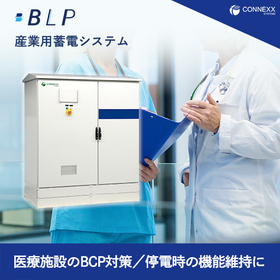Industrial storage batteries that contribute to the decarbonization of school facilities and disaster prevention measures.
Industrial storage batteries from CONNEXX SYSTEMS
Promoting measures against global warming, environmental education, and initiatives aimed at decarbonization, as well as the introduction of industrial storage batteries as a power source during disasters, are effective.
▼Benefits of Introducing Storage Batteries in School Facilities With the promotion of the Ministry of Education, Culture, Sports, Science and Technology, the introduction of storage batteries in school facilities is progressing. Not only schools and community centers but also welfare facilities are highly likely to serve as evacuation centers, and more facilities are considering the introduction of renewable energy equipment and storage batteries as measures for disaster preparedness. About half of public elementary and junior high schools have been in use for over 40 years, and as the aging of school facilities reaches its peak, there is a demand for environmental burden reduction measures in school facilities aimed at achieving carbon neutrality by 2050 through "energy conservation" via high insulation and high-efficiency air conditioning, as well as "energy creation" using renewable energy. Furthermore, as a countermeasure against increasingly severe disasters, it has become essential to strengthen the evacuation functions of facilities, including indoor gymnasiums that serve as community evacuation centers. The introduction of industrial storage batteries combined with solar power generation in school facilities is expected to not only secure power supply during emergencies and enhance evacuation functions but also serve as educational materials for environmental education, reduce costs, and lower environmental impact. More school facilities are considering the introduction of renewable energy equipment and storage batteries as measures for disaster preparedness.
Inquire About This Product
basic information
Current Status and Challenges of Introducing Solar Power Generation Equipment in School Facilities The Ministry of Education, Culture, Sports, Science and Technology states that in the process of making school facilities ZEB (Net Zero Energy Buildings), it is effective to install solar power generation equipment with a capacity of 50 to 100 kW in addition to energy conservation. However, the current situation in Japan is that many school facilities have small-capacity equipment. Considering the need for power supply during emergencies and the strengthening of evacuation functions as preparation for disasters, a certain scale of storage batteries is essential to effectively utilize surplus electricity. School facilities are not only expected to increase the installation rate of equipment but also to make substantial contributions to decarbonization through the introduction of large-scale equipment, including storage batteries. Benefits of Introducing Industrial Storage Batteries in School Facilities - Reduction of environmental impact - Educational materials for environmental education - Strengthening disaster prevention functions as evacuation centers (BCP measures / securing power supply during emergencies) - Reduction of electricity costs after installation - Effective use of space Source: Current Status and Challenges of Introducing Solar Power Generation Equipment in School Facilities https://www.jstage.jst.go.jp/article/kansaisea/49/0/49_1/_pdf
Price range
Delivery Time
Applications/Examples of results
◯ Decarbonization Leading Regions Decarbonization leading regions are areas that aim to reduce greenhouse gas emissions in line with their local characteristics towards achieving carbon neutrality by 2050. Efforts will be made in at least 100 regions by the fiscal year 2025. Based on the "Regional Decarbonization Roadmap," the Ministry of the Environment is soliciting regions that will achieve requirements such as "substantial zero CO2 emissions associated with electricity consumption in the residential and commercial sectors" by the fiscal year 2030, tailored to local characteristics. Source: Ministry of the Environment "Decarbonization Regional Development Support Site" https://policies.env.go.jp/policy/roadmap/preceding-region/ ◯ Disaster Prevention Measures with Industrial Storage Batteries It is anticipated that a major earthquake with a seismic intensity of 6 or higher will occur with high probability within the next 30 years. If electricity is stored in batteries, it can be used continuously, allowing for preparedness in emergencies as part of business continuity planning (BCP). Source: Cabinet Office Homepage "Disaster Prevention Information Page" https://www.bousai.go.jp/kyoiku/hokenkyousai/jishin.html
Detailed information
-

●Impact of Climate Change <Active Efforts to Reduce CO2 Emissions in Japan> Japan has set a goal to achieve carbon neutrality by 2050, and various measures are being required from municipalities, businesses, and individuals. As global warming accelerates, efforts to reduce CO2 emissions and initiatives to enhance energy conservation in offices and facilities are becoming increasingly common. Measures to reduce the environmental impact of school facilities are being sought to realize carbon neutrality by 2050. Promoting initiatives as a school that contribute to a decarbonized society leads to improved awareness among students and contributes to the local community.
-

● Intensification and Frequency of Natural Disasters Localized heavy rains, typhoons, and accompanying strong winds and river floods are occurring with unprecedented scale, leading to frequent disasters. One of the common consequences of these events is power outages. Furthermore, the frequency of large-scale power outages has been increasing year by year.
-

●Utilization of Renewable Energy Efforts that consider the environment, such as promoting the introduction of renewable energy, are being demanded. Renewable energy is essential for achieving a decarbonized society. Measures to reduce the environmental impact of school facilities are required in order to realize carbon neutrality by 2050. It is necessary to engage in mitigation measures through the reduction of greenhouse gas emissions, improvement of energy efficiency, and the introduction of renewable energy. In regions that are leading in decarbonization, initiatives for decarbonization through the introduction of renewable energy facilities, including storage batteries, in school facilities have already begun.
-

●Benefits of schools introducing solar power generation and industrial storage batteries - Can be used for environmental education - Can reduce electricity costs - Can be utilized as a power source during disasters - Contributes to measures against global warming - Can take advantage of subsidies
-

● You can save on electricity costs. Industrial storage batteries significantly enhance energy-saving effects when linked with renewable energy devices such as solar power generation. Charge the storage battery during low-cost time periods (mainly at night). By using electricity from the charged storage battery during high-cost time periods, you can save on electricity bills.
-

● Backup for three-phase power supply equipment is possible CONNEXX SYSTEMS' industrial storage batteries can provide a three-phase, three-wire output of 30kW, which can be used for necessary lighting, air conditioning, mobile phone charging, and also for power equipment such as water supply pumps in shelters and other locations.
-

The introduction of storage batteries and solar power generation in school facilities can be expected to serve as educational materials for environmental education and to reduce environmental impact.
-

●Batteries contribute to strengthening disaster resilience In recent times, there is a growing demand for preparedness to continue essential operations even during emergencies such as natural disasters. Many facilities are advancing their disaster response plans by combining energy storage batteries with solar power generation to reduce energy consumption through renewable energy. Furthermore, the increasing demand for energy storage batteries combined with solar power generation from public facilities that serve as hubs during disasters indicates that this trend is expanding. Why not prepare for power outages caused by unpredictable natural disasters with energy storage batteries?
Line up(4)
| Model number | overview |
|---|---|
| LB0610GS-DC (DC link compatible model) | Industrial Energy Storage System LUVIS / DC link compatible model that can directly input solar power into the battery. The industrial energy storage system LUVIS features a DC link model (LB0610GS-DC) that allows solar power to be stored in its direct current form. By reducing the number of power conversions, it minimizes power loss, improves the utilization efficiency of the battery, and enables direct current power supply with minimal energy loss. |
| LB0610GS-AC (AC link compatible model) | This is an industrial storage system that pursues the best balance of efficient output and storage capacity while keeping installation costs down with a reasonable system design. It achieves reductions in electricity costs through self-consumption in conjunction with solar power generation and provides measures against power outages during disasters. It contributes to the effective use of renewable energy and CO2 reduction, and by enabling energy consumption reduction through energy creation, it supports efforts towards decarbonization. It encompasses functions that promote energy conservation and the advancement of SDGs management. |
| LB0700HN | The industrial storage system <BLP> enables full-scale business continuity during disasters. The BLP has a storage capacity of 73.7 kWh and a rated output of 30 kW (three-phase three-wire type), making it a high-capacity, high-output industrial three-phase storage system. It is a compact outdoor installation that integrates the PCS and battery enclosure, contributing to space-saving. It can be introduced at a low cost and in a short period. The system is ideal for BCP applications, as the necessary capacity can be reasonably increased as needed during emergencies. |
| LB0700HN-S | Industrial storage battery system <BLP> salt damage countermeasure model / It can be safely installed in coastal areas and regions with heavy salt damage. For batteries that are not designed to withstand salt damage, it is necessary to store them in dedicated enclosures such as containers, which can lead to issues with size, installation location, and cost. With the salt damage countermeasure model, installation is now possible in areas that were previously given up on, significantly expanding the installation scenarios for industrial storage batteries. |
catalog(8)
Download All Catalogs

Company information
"Transforming energy infrastructure with innovative energy storage technology" We aim to promote regional energy independence and contribute to the creation of a clean and resilient future energy infrastructure. CONNEXX SYSTEMS is a startup company that, with this vision in mind, challenges innovations in energy storage technology that far exceed conventional wisdom. Energy storage is the "bond" that connects today's energy to the energy of the future. CONNEXX SYSTEMS contributes to the creation of a safe and secure future society through innovative energy storage solutions. CONNEXX SYSTEMS primarily engages in the development, manufacturing, sales, and planning design of next-generation energy storage systems, among other business activities. We also provide system integration services. Through the accumulation of our unique technologies, we continue to evolve our energy storage systems to offer to our customers.






![Industrial storage batteries contributing to the promotion of sustainable logistics [Environmental consideration and cost reduction]](https://image.www.ipros.com/public/catalog/image/01/e12/778282/IPROS9238720460839623270.jpeg?w=120&h=170)









